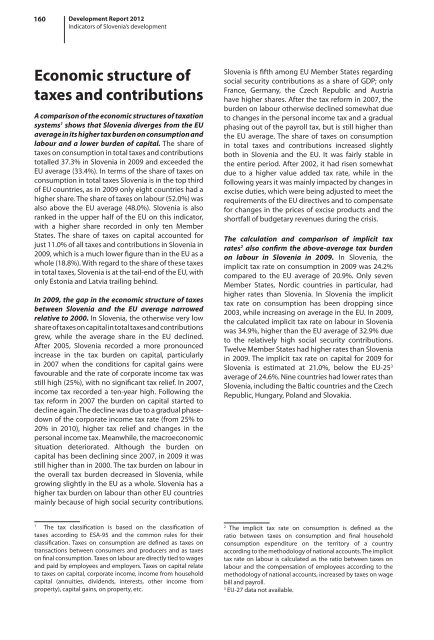development report 2012 - UMAR
development report 2012 - UMAR
development report 2012 - UMAR
Create successful ePaper yourself
Turn your PDF publications into a flip-book with our unique Google optimized e-Paper software.
160 Development Report <strong>2012</strong><br />
Indicators of Slovenia’s <strong>development</strong><br />
Economic structure of<br />
taxes and contributions<br />
A comparison of the economic structures of taxation<br />
systems 1 shows that Slovenia diverges from the EU<br />
average in its higher tax burden on consumption and<br />
labour and a lower burden of capital. The share of<br />
taxes on consumption in total taxes and contributions<br />
totalled 37.3% in Slovenia in 2009 and exceeded the<br />
EU average (33.4%). In terms of the share of taxes on<br />
consumption in total taxes Slovenia is in the top third<br />
of EU countries, as in 2009 only eight countries had a<br />
higher share. The share of taxes on labour (52.0%) was<br />
also above the EU average (48.0%). Slovenia is also<br />
ranked in the upper half of the EU on this indicator,<br />
with a higher share recorded in only ten Member<br />
States. The share of taxes on capital accounted for<br />
just 11.0% of all taxes and contributions in Slovenia in<br />
2009, which is a much lower figure than in the EU as a<br />
whole (18.8%). With regard to the share of these taxes<br />
in total taxes, Slovenia is at the tail-end of the EU, with<br />
only Estonia and Latvia trailing behind.<br />
In 2009, the gap in the economic structure of taxes<br />
between Slovenia and the EU average narrowed<br />
relative to 2000. In Slovenia, the otherwise very low<br />
share of taxes on capital in total taxes and contributions<br />
grew, while the average share in the EU declined.<br />
After 2005, Slovenia recorded a more pronounced<br />
increase in the tax burden on capital, particularly<br />
in 2007 when the conditions for capital gains were<br />
favourable and the rate of corporate income tax was<br />
still high (25%), with no significant tax relief. In 2007,<br />
income tax recorded a ten-year high. Following the<br />
tax reform in 2007 the burden on capital started to<br />
decline again. The decline was due to a gradual phasedown<br />
of the corporate income tax rate (from 25% to<br />
20% in 2010), higher tax relief and changes in the<br />
personal income tax. Meanwhile, the macroeconomic<br />
situation deteriorated. Although the burden on<br />
capital has been declining since 2007, in 2009 it was<br />
still higher than in 2000. The tax burden on labour in<br />
the overall tax burden decreased in Slovenia, while<br />
growing slightly in the EU as a whole. Slovenia has a<br />
higher tax burden on labour than other EU countries<br />
mainly because of high social security contributions.<br />
Slovenia is fifth among EU Member States regarding<br />
social security contributions as a share of GDP; only<br />
France, Germany, the Czech Republic and Austria<br />
have higher shares. After the tax reform in 2007, the<br />
burden on labour otherwise declined somewhat due<br />
to changes in the personal income tax and a gradual<br />
phasing out of the payroll tax, but is still higher than<br />
the EU average. The share of taxes on consumption<br />
in total taxes and contributions increased slightly<br />
both in Slovenia and the EU. It was fairly stable in<br />
the entire period. After 2002, it had risen somewhat<br />
due to a higher value added tax rate, while in the<br />
following years it was mainly impacted by changes in<br />
excise duties, which were being adjusted to meet the<br />
requirements of the EU directives and to compensate<br />
for changes in the prices of excise products and the<br />
shortfall of budgetary revenues during the crisis.<br />
The calculation and comparison of implicit tax<br />
rates 2 also confirm the above-average tax burden<br />
on labour in Slovenia in 2009. In Slovenia, the<br />
implicit tax rate on consumption in 2009 was 24.2%<br />
compared to the EU average of 20.9%. Only seven<br />
Member States, Nordic countries in particular, had<br />
higher rates than Slovenia. In Slovenia the implicit<br />
tax rate on consumption has been dropping since<br />
2003, while increasing on average in the EU. In 2009,<br />
the calculated implicit tax rate on labour in Slovenia<br />
was 34.9%, higher than the EU average of 32.9% due<br />
to the relatively high social security contributions.<br />
Twelve Member States had higher rates than Slovenia<br />
in 2009. The implicit tax rate on capital for 2009 for<br />
Slovenia is estimated at 21.0%, below the EU-25 3<br />
average of 24.6%. Nine countries had lower rates than<br />
Slovenia, including the Baltic countries and the Czech<br />
Republic, Hungary, Poland and Slovakia.<br />
1<br />
The tax classification is based on the classification of<br />
taxes according to ESA-95 and the common rules for their<br />
classification. Taxes on consumption are defined as taxes on<br />
transactions between consumers and producers and as taxes<br />
on final consumption. Taxes on labour are directly tied to wages<br />
and paid by employees and employers. Taxes on capital relate<br />
to taxes on capital, corporate income, income from household<br />
capital (annuities, dividends, interests, other income from<br />
property), capital gains, on property, etc.<br />
2<br />
The implicit tax rate on consumption is defined as the<br />
ratio between taxes on consumption and final household<br />
consumption expenditure on the territory of a country<br />
according to the methodology of national accounts. The implicit<br />
tax rate on labour is calculated as the ratio between taxes on<br />
labour and the compensation of employees according to the<br />
methodology of national accounts, increased by taxes on wage<br />
bill and payroll.<br />
3<br />
EU-27 data not available.
















